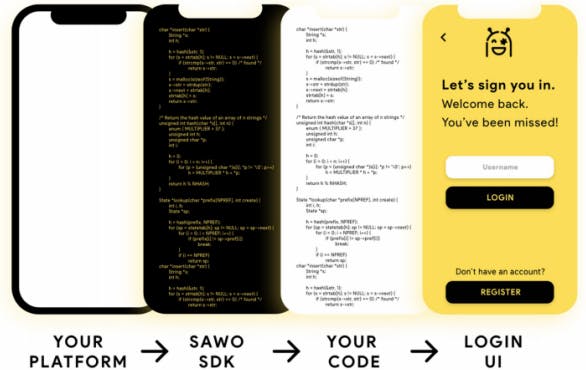Passwordless Authentication System
How a Passwordless Authentication System (like SAWO) works
An Authentication system involves both confirming the authenticity of the user as well as the device through which requests are being sent. The most common passwordless authentication methods include verifying the possession of a secondary device or account a user has which can be done through digital identity.
Instead of passwords or OTPs for authentication of the device, the user provides some other form of evidence such as a digital signature or a cryptographic pair of the public-private keys to authenticate the system. It is often used in conjunction with Multi-factor Authentication (MFA) and Single Sign-On (SSO) solutions to improve the user experience, strengthen security and reduce IT operation expense and complexity.
SAWO is an easy drop-in solution to add a passwordless authentication layer to the applications. It saves businesses the cost, time, and risk that come with building their own solution to authenticate users.
Technology behind Passwordless Authentication
The technology behind Passwordless login is similar to that of digital certificates. There are cryptographic key pairs that include a public and a private key, which have their literal meaning.
The security of a passwordless authentication system depends on the proofs of identity required in lieu of the passwords and their implementation. The user device can be verified by soft tokens or digital signatures.
Digital Signatures
Digital signatures use a public key system, which is considered the best way for digital identity authentication and encryption. It works by using two related keys, a public key and a private key as mentioned above in the case of digital certificates. These two keys together create a key pair to encrypt and decrypt a message using strong key cryptography algorithms.
The SAWO SDK is a transparent layer of security between the user and the platform. After a simple user registration process, SAWO identifies the user and then issues these two keys to the user. Notifications to the account holder's device are generally considered more secure than passwordss.

Both public and private keys are generated using a mathematical algorithm to provide the client with their own digital identity. The digital signature is generated and encrypted using that user's private key and also a timestamp. These keys can be safely stored by the developer in the user's browser.
A private key is stored on the local device of the user and linked to an authentication factor, may it be the email, phone, or device IP address. A user signs using the private key. The user's device retains the private key.
The public key on the other hand goes to the website or the application when the user wishes to log in. When a user tries to log in, the server sends a challenge to the user's device and the authentication is done by the client device by using the private key and proving possession. This kind of signing of challenge can only happen through a user device which makes it secure and at the same time eliminates the need for passwords. The identity of the device/user is verified by the user's public key which is sent to the server on every request.
The cryptographic key pair mechanism which matches the public key with a device store private key makes passwordless authentication the most secure type of authentication available. Read what makes passwordless authentication better than Single Sign-On and Social Logins.

